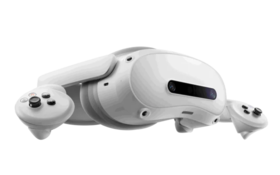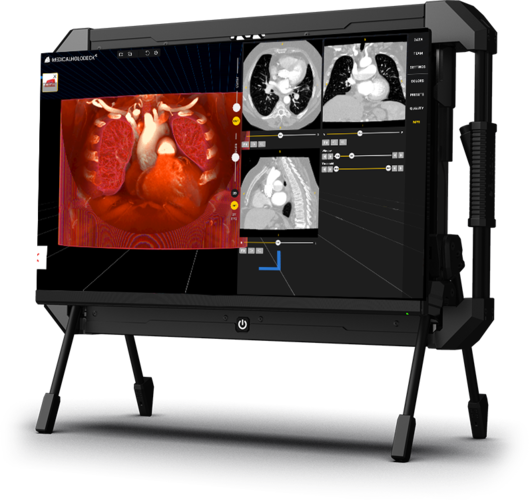

Acer Spatiallabs
Samsung Odyssey 3D
Barco Eleusis
Also compatible with standard
2D screens on Windows.


Anatomy Master enhances the understanding of human anatomy more effectively and efficiently compared to traditional methods like screen-based learning or textbooks. This application offers a dynamic learning experience where users can interact with anatomical data by walking around, enlarging, dissecting, and making cross-sectional views of the models, allowing for observation and study from any angle and perspective.
Anatomy Master facilitates a rapid and enhanced understanding of the human body, its organs, and physiology. Utilizing this tool leads to a deeper comprehension of human anatomy, resulting in more proficient medical students, nurses, and healthcare professionals.
With Medicalholodeck, educators have the capability to create their own lessons and simulations in VR. This feature allows for the recording of teachings for VR replay, enabling the development of a comprehensive library of anatomy lessons.
Anatomy Master can be effectively utilized in virtual classrooms or for individual student self-study, enhancing the learning curve and contributing to the improved education of future medical professionals through VR technology.



Anatomy Master XR presents high-quality, three-dimensional human anatomy in VR, ideal for teaching and studying the human body in immersive virtual classrooms.
The application includes precise male and female anatomy models, developed based on real patient data, ensuring accuracy and reliability in virtual reality. Medicalholodeck has developed the models in collaboration with leading experts to ensure a professional-grade educational tool.
Over 2000 anatomical structures and organs are meticulously annotated, supporting detailed study and effective teaching in virtual classroom environments and self-study.
Users can magnify the anatomical models, study them from any perspective, and compare them side-by-side with medical imaging and dissections from our comprehensive anatomy atlas in a fully immersive workspace.
The 3D models are based on CT and MRI data, with textures and structures carefully crafted to accurately represent real-life organs.
The platform enables teaching human anatomy in various settings - from virtual classrooms and VR labs to location-independent global access.
Educators can record anatomy classes, create and store lessons, and share their content globally, allowing users to replay and learn individually.
App content
The head houses essential organs responsible for sensory processing, cognitive functions, and vital physiological activities. The brain, enclosed within the skull, regulates thought, memory, emotion, and motor coordination.
Key sensory organs are located in the head. The eyes are responsible for vision, the ears for hearing and maintaining equilibrium, the nose for olfaction and respiration, and the mouth for gustation, speech, and the initial stage of digestion.
The inner brain contains key structures that support vital body and mental functions. The thalamus relays sensory and motor signals. The hypothalamus controls hunger, thirst, sleep, body temperature, and hormone levels.
The limbic system, including the hippocampus and amygdala, manages memory and emotions. The basal ganglia regulate movement and habits. The brainstem controls breathing, heart rate, and links the brain to the spinal cord. These regions work together to maintain essential brain functions and keep the body in balance.
The human brain, protected by the skull, is the central organ of the nervous system. It controls vital functions, stores memories, and enables decision-making.
Neurons communicate through synapses, creating networks that support behavior, sensation, and perception. Neuroplasticity, the brain’s ability to adapt and reorganize, is essential for learning and recovery, demonstrating its complexity and resilience.
The brain, as the core of the nervous system, processes sensory input and controls body functions. It interprets signals from vision, hearing, taste, smell, and touch.
Each sense is processed in specific brain regions: the occipital lobe for vision, temporal lobes for hearing, parietal lobe for touch, olfactory bulb for smell, and gustatory cortex for taste.
The eye is a vital organ for vision, made up of structures that capture and process light. The cornea, a transparent outer layer, helps focus incoming light. The iris, the colored part of the eye, controls how much light enters through the pupil.
Behind the iris, the lens further focuses light onto the retina. The retina contains photoreceptor cells, rods for low light and peripheral vision, and cones for color and detail. These cells convert light into electrical signals, which are sent to the brain through the optic nerve.
The retina contains rods and cones that convert light into electrical signals. Rods support vision in low light, while cones detect color and fine detail. The macula, especially the fovea at its center, enables sharp central vision.
Visual signals travel through the optic nerve to the brain for processing. The choroid provides oxygen and nutrients to the eye, while the optic disc, where the optic nerve exits, creates a natural blind spot. Together, these structures support precise and dynamic vision.
The ear, responsible for hearing and balance, has three sections: outer ear, middle ear, and inner ear. Each part captures and processes sound waves and maintains equilibrium.
The outer ear consists of the pinna and ear canal, directing sound waves to the eardrum, which vibrates in response. These vibrations pass to the middle ear, where the ossicles amplify and transmit them to the inner ear through the oval window.
The inner ear contains the cochlea and vestibular system. The cochlea, a spiral-shaped organ, uses hair cells to convert vibrations into electrical signals, which travel to the brain via the auditory nerve and are perceived as sound. The vestibular system, including semicircular canals and otolith organs, senses head movement and position, helping maintain balance and spatial orientation.
The neck connects the head to the torso, housing the trachea, esophagus, major blood vessels, and cervical spine. It supports and provides head mobility. The neck has anterior, lateral, and posterior regions, each with muscles, nerves, and lymph nodes for movement, sensation, and immune response.
The larynx, or voice box, below the pharynx, produces sound and protects the trachea from food aspiration. The larynx is vital for breathing, speaking, and swallowing.
The human thorax, or chest, protects the heart, lungs, and essential structures. It is enclosed by the rib cage, which consists of the sternum and ribs, providing structural support and connecting to the shoulder girdle and upper limbs.
The diaphragm, a dome-shaped muscle at the thorax's base, is critical for respiration. It contracts during inhalation to expand the lungs and relaxes during exhalation to expel air. This coordination is vital for effective breathing and respiratory health.
The male abdomen houses vital organs for digestion, excretion, and other functions. Enclosed by abdominal muscles, it provides support, protection, and aids in movement and posture.
Key organs include the stomach, liver, pancreas, small and large intestine. The urinary bladder stores urine, and parts of the reproductive system aid in sperm transport and ejaculation. Major blood vessels and nerves ensure nutrient supply and function regulation. The male abdomen is essential for various physiological processes.
The male pelvis supports the spine and houses key urinary, digestive, and reproductive organs. It is formed by three bones, the ilium, ischium, and pubis, which create a strong framework for muscle and ligament attachment.
Key organs include the bladder and rectum. Pelvic floor muscles support these organs, aiding in continence and bowel movements.
The male skeleton, consisting of 206 bones, provides structural support, protects vital organs, and enables movement. It is divided into two main parts: the axial skeleton and the appendicular skeleton.
The axial skeleton includes the skull, vertebral column, and thoracic cage, forming the body’s central framework.
The appendicular skeleton comprises the pectoral girdle, arm bones, pelvic girdle, and leg bones, allowing for limb movement and connecting the limbs to the axial skeleton.
The back supports body weight, enables movement, and protects the spinal cord. It consists of the vertebral column, muscles, ligaments, and nerves.
Back muscles provide strength for lifting, bending, and twisting, while ligaments connect vertebrae to maintain spinal stability. Nerves branching from the spinal cord ensure communication between the brain and limbs, essential for both movement and sensation.
The spine, or vertebral column, supports the body, allows flexibility, and protects the spinal cord. It is made up of 33 vertebrae divided into five regions: cervical, thoracic, lumbar, sacral, and coccygeal. Intervertebral discs between vertebrae cushion and allow flexibility.
The sacrum connects the spine to the pelvis, distributing weight, while the tailbone serves as an attachment point for muscles and ligaments. The spine surrounds the spinal cord, which carries signals between the brain and body. Ligaments and muscles attached to the spine ensure stability, mobility, and protect neural structures.
The upper limb, which includes the shoulder, arm, forearm, wrist, and hand, allows a wide range of movements and functions.
Its skeletal framework consists of the pectoral girdle, upper arm, and forearm. The wrist contains eight carpal bones, while the hand has five metacarpals and fourteen phalanges.
Major muscles include the deltoid (shoulder), biceps brachii and triceps brachii (elbow), and various forearm muscles that control the wrist and fingers. Nerves from the brachial plexus provide both motor control and sensory input.
The lower limb supports weight, enables movement, and maintains balance. It includes the hip, thigh, knee, leg, ankle, and foot.
Key bones include the pelvic girdle, femur, tibia, fibula, and the bones of the ankle and foot.
Major muscles include gluteals (hip movement), quadriceps (knee extension), hamstrings (knee flexion and hip extension), calves (plantar flexion), and foot muscles.
The muscular system enables movement, maintains posture, and supports vital functions with three muscle types: skeletal, smooth, and cardiac.
Skeletal muscles are voluntary, attaching to bones via tendons for movements like walking and lifting. They work in pairs, with one muscle contracting while the other relaxes. Key muscles include biceps, triceps, quadriceps, hamstrings, pectorals, and abdominals.
Smooth muscles are involuntary, found in organs like the stomach, intestines, blood vessels, and bladder.
Cardiac muscle, found only in the heart, is specialized and involuntary.
The hand is essential for tasks from fine motor skills to powerful grasps. It is made up of bones, muscles, tendons, ligaments, nerves, and blood vessels.
The hand contains 27 bones: 8 carpals in the wrist, 5 metacarpals in the palm, and 14 phalanges in the fingers. The carpal bones allow wrist movement, the metacarpals support the fingers, and each finger has three phalanges except the thumb, which has two.
The foot supports body weight, enables movement, and maintains balance through its bones, muscles, tendons, ligaments, nerves, and blood vessels.
It contains 26 bones: 7 tarsals, 5 metatarsals, and 14 phalanges. The tarsals form the arches, metatarsals connect to the phalanges, and each toe has three phalanges except the big toe, which has two.
Intrinsic foot muscles control fine movements and support the arches, while extrinsic muscles from the lower leg generate larger movements like walking and running. Important tendons, such as the Achilles tendon, connect muscles to bones, and ligaments like the plantar fascia provide arch support.
Teeth are crucial for biting, chewing, and speaking. Humans have two sets of teeth: primary (baby) teeth and permanent (adult) teeth, with adults typically having 32. These are divided into incisors for cutting, canines for tearing, premolars for crushing, and molars for grinding food.
Each tooth has a crown, a root and a neck (where the crown and root meet). The crown is covered by enamel, the hardest substance in the body.
Female breasts, composed of glandular tissue, fat, and connective tissue, are crucial for lactation. Glandular tissue produces milk, which ducts transport to the nipple, surrounded by the areola. Fat tissue determines size and shape, while connective tissue provides support.
The female pelvis supports the upper body, protects reproductive organs, and aids childbirth. It includes the ilium, ischium, pubis, sacrum, and coccyx, connecting the spine to the lower limbs.
The pelvic cavity contains the uterus, ovaries, and fallopian tubes. The uterus hosts pregnancy, ovaries produce eggs and hormones, and fallopian tubes enable egg passage and fertilization.
The head houses essential organs responsible for sensory processing, cognitive functions, and vital physiological activities. The brain, enclosed within the skull, regulates thought, memory, emotion, and motor coordination.
Key sensory organs are located in the head. The eyes are responsible for vision, the ears for hearing and maintaining equilibrium, the nose for olfaction and respiration, and the mouth for gustation, speech, and the initial stage of digestion.
Works with standalone and PC VR systems. See supported headsets and specs. Enhanced Quest 2 performance: utilize Remote Rendering for optimal experience. Purchase cloud hours or contact us for more info.
Unsure about integrating Anatomy Master into your teaching? Contact us for a personalized demonstration.
Anatomy Master is a versatile educational tool, ideal for:
Works alongside all Medicalholodeck applications, including Dissection Master XR and Medical Imaging XR. Utilize our Medicalholodeck TeamXR system for collaborative learning and teaching experiences.
Table of contents
High-quality three-dimensional visualization is crucial for understanding human anatomy, particularly in the initial stages of medical education. Virtual reality offers an immersive and detailed perspective that enhances learning.
Utilizing VR, students can explore the human body's organs and anatomical structures in a more interactive and engaging manner. This approach elevates the quality of education and student performance, fostering the development of the next generation of medical professionals in a virtual reality environment.
Offering complete three-dimensional anatomical insights in VR significantly improves students' grasp of human anatomy. This method is more efficient and effective compared to traditional learning resources, facilitating faster and deeper comprehension.
Virtual classrooms in the metaverse enable location-independent teaching, creating opportunities for international collaboration and learning. Medicalholodeck's comprehensive medical XR applications provide a platform for teaching, studying, and learning anatomy in an innovative way.
Educators can easily create, store, and share their anatomy lessons and simulations with a simple click, making these resources readily accessible to users in the metaverse. This feature enhances the distribution and accessibility of educational content in the field of medical education.
Anatomy Master, in conjunction with Medicalholodeck's suite of applications, offers an effective platform for teaching human anatomy in a virtual reality environment. Educators can create interactive virtual classrooms for real-time instruction or use RecordXR to record and share their lessons, enhancing the learning experience.
The integration of VR in teaching anatomy allows for the inclusion of DICOM, 3D, and 2D files to create comprehensive teaching materials, lessons, and simulations for VR replay. Medicalholodeck can significantly upgrade existing anatomy and simulation labs, facilitating the transition of simulation experiences to the metaverse with ease.
Students can explore and understand human anatomy in virtual reality using detailed 3D models and advanced dissection data. Medicalholodeck offers an immersive learning environment, enabling efficient and successful study of anatomy in VR. This approach not only saves time but also deepens the understanding of anatomical concepts.
Medical professionals can use Anatomy Master for clinical training, demonstrating surgical procedures and anatomical correlations in a risk-free VR environment. This can enhance the understanding of complex medical procedures for both students and practicing clinicians.
Doctors and healthcare providers can utilize the app to explain medical conditions, surgical procedures, and treatment plans to patients, aiding in better patient understanding and involvement in their own healthcare decisions.